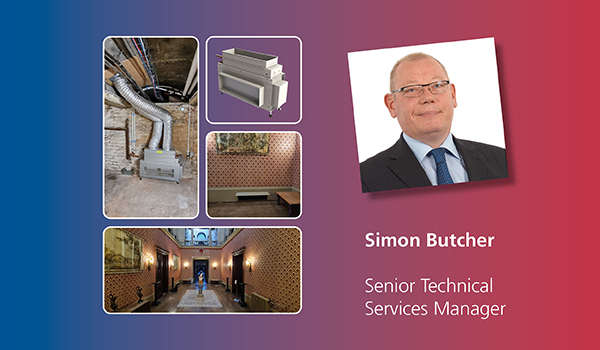Simon Butcher – Senior Technical Services Manager for Smith’s Environmental Products
It must be a real challenge to provide modern efficient heating for historic buildings without compromising the aesthetics…
Finding a way to provide heating in historic buildings is a challenge that is not easily overcome. The reluctance to detract from the aesthetic and architectural fabric of culturally significant buildings is understandable. Often it is not just a desire to avoid ungainly heat emitters but also a requirement. A good example of such a dilemma was presented to me at Grittleton House near Cirencester. This magnificent Victorian Manor House boasts many original features, built for entertaining, with its large ballroom, cosy library and elegant social spaces as well as an impressive orangery overlooking the Italian sunken gardens. Today it is spectacular wedding venue providing grandeur and style.
This project required a heating solution that can work on biomass and their oil boiler supplied system. Consideration was given as to how the new heating system could be integrated into the building without altering the aesthetics of the rooms. Beneath the floors was hidden brick ducting running from the service passages up into the impressive reception rooms and hall. To capitalise on the pre-existing ducting Smith’s Caspian UVC fan convectors were installed in the subterranean wine cellars and service passages beneath the stately home. Ducts were employed to transfer the warm air from the Caspian UVC fan convectors to heat the vast spaces above. Other ducting was used to provide the return air back into the underfloor passages. The use of Caspian UVC meant that the brief of providing heat emitters that could heat the very large spaces quickly whilst avoiding having any emitters within the historical spaces was achieved.
Do you have any other examples where you have used a ‘hidden’ solution in a historic building?
A similar solution was required at Liverpool Town Hall where 20 Caspian UVC concealed units were hidden behind panels in the walls of various rooms within the building, enabling visitors to feel the effects of the heat without having to see the products. The concealment of the fan convectors has been done without any compromise to the internal fabric of the building or to the fan convection heating.
In north London at the Grim’s Dyke hotel Caspian UVC fan convectors were installed in a number of rooms, including the restaurant and the prestigious music room, which has four Caspian UVC’s carefully concealed in the fabric of the building. The concealment of the fan convectors has been done beautifully, without any compromise to the internal fabric of the building or to the fan convection heating.
Is Caspian UVC the only way to provide discreet heating in historic buildings?
Caspian UVC fan convectors are not the only solution to heat older historic buildings. A good example of a more recognisable fan convector is at Doddington Hall on the outskirts of Lincoln. A fine example of a late Elizabethan Mansion it is alive with history and interest. Built by Robert Smythson the building retains nearly all of its original design features. Doddington itself is still very much a family home, although some income is generated through public tours of the spectacular 90ft Long Gallery with its collection of superb paintings, along with other rooms that have been granted public access. Doddington is also renowned for hosting weddings and other large corporate events. A solution was needed when upgrading the heating system that would be able to adequately heat the expansive spaces. Careful consideration was needed with the provision of heating particularly in the top floor gallery which had never previously been heated. The overriding concern throughout the building was to prevent overheating, as this would have a potentially negative affect on the antique furnishings and artwork. The Caspian FF and UVC units were deployed to provide a discreet solution. To enhance this further, many of the units were produced in colours to match the historic and beautiful interiors.
The Caspian FF units have been used with a reverse air flow to further reduce any impact on artefacts and exhibits. Blending valves were installed to reduce the flow temperature to 50°C, which effectively turned the Caspian FF units into Low Surface Temperature (LST) units, but the outputs can be increased by raising the flow temperature if required.
How do you control these fan convectors when they are installed in pretty inaccessible places?
Doddington Hall is a good example of using controls to provide a bespoke solution for each room. Fan speed controls were provided on the units in varying positions, to allow the staff and family to control the output, whilst maintaining the required aesthetics. Every room is controlled by an RF room stat and where there is more than one heater in a room, they are linked together by a 0 – 10V signal cable. This solution again helped to reduce to a minimum any unwarranted visual impact of thermostats.
There is certainly an increase in the interest in more sophisticated control systems now. Our Smart Controls are becoming more widely specified whereby remote monitoring and management of the heat emitters and heating system can be managed via an app on a mobile phone or tablet so a facilities manager, or even a heating engineer can keep an eye on things from afar. Smart Controls also offer a much more accurate control of the heat emitters.
The beauty of installing fan convectors in historical buildings is that as well as being able to blend into the fabric of the buildings they also can provide high heat outputs to quickly heat large spaces when required and then maintain heating comfort quietly in the background.
www.smithsep.co.uk | 01245 324900 | sales@smithsep.co.uk

